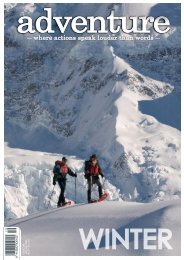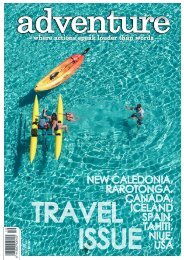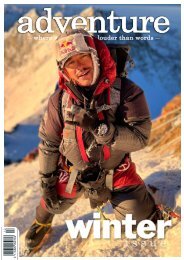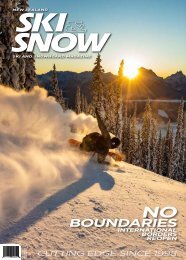Adventure Magazine Feb 2020
Issue #218 - The Escape Issue Immerse yourself in adventure, active travel, products, gear and more.
Issue #218 - The Escape Issue
Immerse yourself in adventure, active travel, products, gear and more.
Create successful ePaper yourself
Turn your PDF publications into a flip-book with our unique Google optimized e-Paper software.
"The 600m-high
dihedral splits the
main face of Mt
Indefatigable from the
first move to the final
top-put. A stunning,
unique feature.”
Many of the best bolted climbs - where you don’t
need to place your own rock protection as you climb -
were an outrageously convenient five-minute drive from
town. This was mind-blowing to someone who was used
to the 10-hour round-trip that is Wellington (see Taupo)
rope-climbing. Even the alpine climbing wasn't far away.
Yamnuska? Twenty minutes to the car park. Lake Louise?
An hour.
One day, we dared to venture beyond an hour's
drive, heading deep into the Kananaskis Range in search
of a beautiful corner, aptly named Joy (grade 5.6,14).
The 600m-high dihedral splits the main face of Mt
Indefatigable from the first move to the final top-put. A
stunning, unique feature.
Every climb seemed to have something special.
Takakkaw Falls, in Yoho National Park, has a belay position
a stone's throw from a raging waterfall. Then, above a
typically loose, unprotectable shale pitch, a giant hole in
the face leads you into the darkness. The route requires
you to crawl on hands and knees along this 30m-long
cave. It is understandably damp, a remnant from a time
when the waterfall was even more immense. It narrows
just enough to force you to drop into a belly-shuffle, before
you emerge into the light next to the apex of the waterfall
and its narrow, sharp channels and deafening roar. Not
recommended for the claustrophobic.
Sir Donald, at 3284m, is a dark triangle that
dominates the skyline in Rogers Pass, and looks like it
belongs in the Himalaya. It offers a delightful grade 5.4
(12) scramble up the Northwest Ridge, slowly rising above
the surrounding glaciers and rugged peaks.
The back of Lake Louise is considered to be the
cragging jewel in the Rockies Crown. Anyone who passes
through with only a week to climb is told to head directly
there. The rock is quartzite, often with vertical cracks
and horizontal in-cuts for hands and fingers to surmount
overhanging sections. There are roofs, arétes, technical
faces, cracks - sometimes all in one steep, magnificent
line. And the setting is stunning. The hue of Lake Louise
seems to be infused with a purity of blue that doesn't exist
anywhere else.
Morraine Lake is in the same area, at the head of the
Valley of Ten Peaks. A stroll up the valley not only gives you
a view of several peaks that resemble the bottom jawline
of some mammoth, prehistoric predator, but also brings
you to the free-standing, 100m-high pillar known as the
Grand Sentinel.
Of the few lines on it, Cardiac Aréte (grade 5.10d,
20) is the stand-out. Four bolted pitches up a sharp,
aesthetic aréte, with wild exposure and a nearby glacier
that frequently releases boulder torpedoes to the talus
below. At the top of the route is a flat platform which
seems custom-built to pose for summit photographs and
bask in the euphoria that comes with the sheer pleasure
of beautiful climbing in a magnificent position.
24//WHERE ACTIONS SPEAK LOUDER THAN WORDS/#218

















